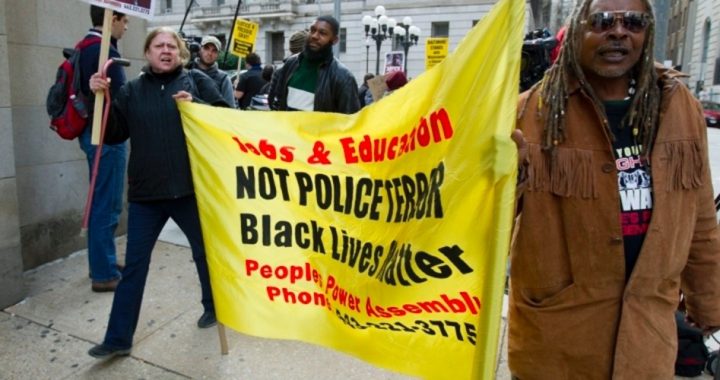
A Baltimore circuit court judge declared a mistrial Wednesday in the case of Baltimore police officer William Porter. Porter is one of six officers charged in the death of Freddie Gray on April 12, 2015. After three days of deliberations the jury told Judge Barry G. Williams that it was unable to return a unanimous verdict on any of the charges.
An autopsy found that Freddie Gray, a 25-year-old black man, died as the result of injuries sustained while in police custody. He was handcuffed — but not restrained by a seatbelt — while being transported in a police van after his arrest. The question is how he received those injuries.
The prosecution claims that he was thrown from his seat either during a turn or while the van was coming to a stop. The defense claims — based on a statement given by another suspect in the van — that Gray caused his own injuries in an attempt to avoid going to jail.
It appears he struck his head on the metal wall of the van and suffered a spinal cord injury. Gray slipped into a coma and was taken to a trauma center. He died one week later.
The day before Gray’s death — April 18, 2015 — the protests began. One week into the protests, riots and looting rocked Baltimore as protesters turned violent, setting fires and throwing rocks. More rioting and looting followed Gray’s funeral two days later. Before the violence died down, at least six officers were seriously injured and nine others suffered less serious injuries, two patrol cars were destroyed, a CVS pharmacy was burned down, the National Guard was called in, and a city-wide curfew was put in place.
Race was a primary factor in the protests, even though three of the officers charged are black.
On May 1, 2015, Baltimore City State’s Attorney Marilyn Mosby announced that the medical examiner had ruled the death a homicide and that her office had charged all six officers involved. The charges varied from officer to officer and included everything from false arrest to second-degree depraved-heart murder. A grand jury indicted the officers on all of the original charges except false arrest and illegal imprisonment. The grand jury also added charges of reckless endangerment and misconduct in office against all six officers, according to the New York Times.
In September, 2015, Baltimore Mayor Stephanie Rawlings-Blake announced a payment of $6.4 million to the family of Freddie Gray, calling it a settlement for all civil claims in his death while in the custody of Baltimore police, even though no lawsuit had ever been filed. As The New American reported then, the mayor hinted that the “settlement” was a way to pacify the city’s angriest residents in order to avoid “harm to the community” and “divisiveness.” In announcing the payoff, she said:
We must weigh the potential financial cost of defending the lawsuits in court and the potential exposure to the citizens of the city of Baltimore if we are unsuccessful in court — and for that matter if we are successful in court. In this case, faced with the prospect of significant legal expenses involved in an extended federal lawsuit as well as the potential liability that could come with an unfavorable jury verdict, our city’s attorneys came to the conclusion that the six-point-four million dollars settlement is in the best interests of protecting taxpayers…. The purpose of the civil settlement is to bring an important measure of closure to the Gray family, to the community, and to this city, and to avoid years and years of protracted civil litigation and the potential harm to the community and the divisiveness which might result. [Emphasis added.]
Moving into the final stages of this first trial, the city again prepared for violent unrest as protesters organized under several banners, including that of the Black Lives Matter movement. Fearing a not-guilty verdict would lead to increased violence and rioting, the city required all officers to work longer shifts and canceled all weekday time-off. As CNN reported, “Baltimore police canceled leave for officers who had days off from Monday through Friday. Officers will be scheduled to work 12-hour shifts instead of the usual 10 hours.” Baltimore Police Lieutenant Sarah Connolly told the press, “We would rather err on the side of caution and have an abundance of people readily available as needed.” She added. “We are hoping we don’t need them.”
The trial of the six officers revolves around the the issues of Gray not being secured by a seatbelt and the officers not calling for an ambulance once Gray told them he was injured. The Baltimore Police Department had put a new policy in place just days before Gray was arrested that required all suspects and prisoners to be restrained by a seatbelt during transport. Officer Porter has been charged with manslaughter, second-degree assault, misconduct in office, and reckless endangerment.
After hearing all of the evidence and deliberating for more than 15 hours over three days, the jury was unable to decide on a verdict. The judge dismissed the jury after saying that though it had “clearly been diligent,” he could see that “It is clear you will not come to a unanimous agreement on any of the four charges.” WBALTV.com describes the jury as being made up of “eight women and four men” of which eight are black.
Porter left the courthouse without speaking to the press. The lawyers on both sides of the case cited the gag order imposed by the judge and declined to answer any questions, as well.
As soon as the mistrial was announced, protesters — who had already gathered outside the courthouse with ready-made signs — switched from chanting “Send those killer cops to jail!” to shouting “No justice, no peace!” and “Black Lives Matter,” according to the Associated Press. The threat was clear: Only a guilty verdict will protect the city from violence. If a mistrial can elicit such threats, it is reasonable to wonder what might happen in the event of a “not guilty” verdict. It is also reasonable to wonder about the pressure the jurors must feel — not just for the safety of their city but for their own personal safety.
One can almost hear echoes of South Central Los Angeles after the Rodney King verdict of 1992.
Mayor Rawlings-Blake called for protesters to remain peaceful. “We will not, we cannot be defined by the unrest of the spring,” she said. The Baltimore chapter of the NAACP has joined the mayor in calling for peaceful demonstrations, as have members of Gray’s family. Whether the same people who nearly destroyed their own city while screaming that “Black Lives Matter” will listen, remains to be seen.
Photo: AP Images




